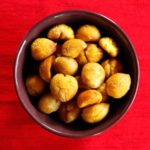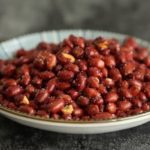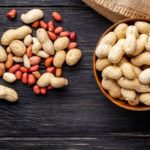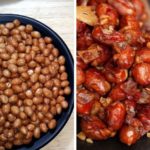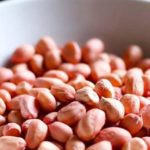Peanuts, or ‘lac’ as they are known in Vietnam, are a beloved snack food. They are often served at drinking sessions for their unique, alluring fragrance and nutty flavor. They are also a popular afternoon snack and can be a delicious side dish for a main meal. Many people like to make a large batch and store them in jars or containers to enjoy throughout the week.
Soaking Peanuts Before Roasting
One common issue with roasted peanuts is that they only stay crispy for a few hours and then become soft and less appealing. The key to maintaining their crispness lies in the preparation. Soaking the peanuts in water before roasting is an essential step. If you skip this step and roast them directly in a pan, they will release oil quickly and become soft and oily.
So, how is this soaking process done, and should you use hot or cold water? How long should they be soaked? Find out the details in the delicious peanut roasting guide below.
Soaking Peanuts Before Roasting
To make delicious and appealing roasted peanuts, start by choosing peanuts with round, plump kernels. Look for those with dry, taut, and smooth silk skin. Remove any shriveled, sprouted, or moldy peanuts as they may contain the toxic compound aflatoxin, which is harmful to health.
Once you’ve selected your peanuts, soak them in a basin of water for 5-10 minutes, then gently rinse them to remove any dirt or residue. This step helps eliminate any remaining dust or impurities on the raw peanuts, reducing any unpleasant odors or astringent tastes.
It is recommended to use warm water for soaking as it helps the peanuts absorb just the right amount of moisture, making them plumper. When exposed to high temperatures, these plumped-up peanuts will heat up more quickly and evenly, resulting in a longer-lasting crispness.
Some chefs and experienced home cooks in Hanoi, famous for their delicious roasted peanuts with basil, also swear by this soaking method or quickly blanching the peanuts in boiling water.
After soaking, let the peanuts rest for a few minutes to drain and dry before roasting.
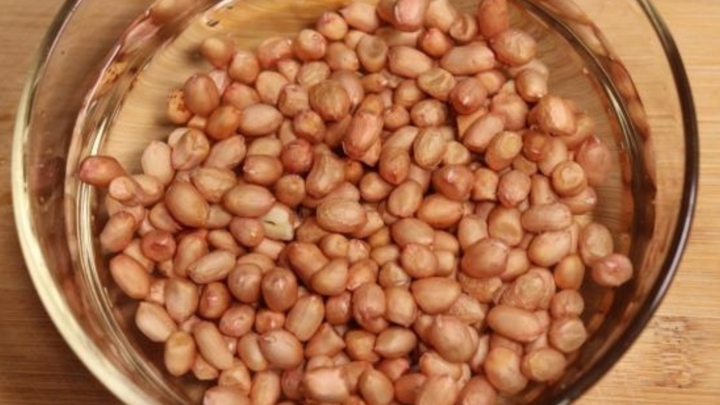 Soaking helps remove dirt and impurities, reducing odors and astringent tastes. (Illustration: Sohu)
Soaking helps remove dirt and impurities, reducing odors and astringent tastes. (Illustration: Sohu)
Roasting Peanuts
Thanks to the creativity of home cooks, there are now numerous delicious ways to roast peanuts. The fundamental principle, however, remains the same: choosing the right temperature to ensure even cooking, a tantalizing aroma, and long-lasting crispness without the oiliness.
Roasting in a Traditional Pan
Adjust your stove to medium or low heat and stir continuously until the peanuts are dry. When they start to emit a nutty aroma, turn off the heat and continue stirring for another 4-5 minutes to allow the heat to dissipate gradually. Taste a few peanuts, and if they have a nutty, buttery flavor, they are perfectly cooked.
In the past, our ancestors used to roast peanuts in clean, dry river sand to ensure even cooking. Some households also add salt during the roasting process to enhance crispness. However, if you don’t have sand or enough salt, you can still achieve delicious results without them.
Roasting in an Oven, Air Fryer, or Microwave
If you’re using an oven or air fryer, start with a temperature between 120°C and 140°C for the first 10 minutes. Then, reduce the heat to 80-100°C for 30-45 minutes to achieve the perfect roast. Remember to stir the peanuts occasionally for even cooking.
The timings mentioned above are approximate and may vary depending on your equipment. Each oven, for instance, may have different heat distribution characteristics, so adjustments may be necessary.
For microwave roasting, spread the peanuts evenly on a ceramic plate and cover them with parchment paper. Place them in the microwave and set it to defrost mode for 1 minute. Then, remove the plate, stir the peanuts, re-cover them, and microwave for another minute. After this cycle, the peanuts will have released some oil. Stir them again and microwave for a final minute in defrost mode.
The most important thing to remember is to stir the peanuts before each cycle and adjust the timings according to your microwave’s power settings.
Resting the Peanuts
In addition to soaking, resting the roasted peanuts is another crucial step to maintain their crispness. Use large sheets of paper towel or soft cloth to rest the peanuts, allowing the heat to dissipate gradually and preventing thermal shock, which can make them soft.
If you plan to store the peanuts in jars or containers, let them cool completely before sealing. Otherwise, the trapped steam can cause the peanuts to become soft, reducing their shelf life and increasing the risk of mold.
Roasting peanuts may seem simple, but these little tips and tricks can make a big difference in achieving the perfect result. Now that you know the importance of soaking and the proper roasting techniques, give it a try the next time you crave this delicious snack.
According to VTC News

























